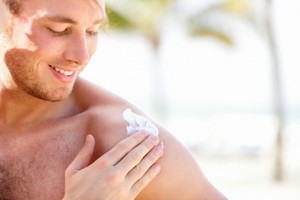 Get the summer soundtrack revved up! It’s beginning to look a lot like sun and fun. That also means your skin is going to get bombarded with those death rays from that big yellow ball of fire in the sky. That might be a little drag queen dramatic, but you still want to take some precautions from the sun and its adverse effects upon your skin.
Get the summer soundtrack revved up! It’s beginning to look a lot like sun and fun. That also means your skin is going to get bombarded with those death rays from that big yellow ball of fire in the sky. That might be a little drag queen dramatic, but you still want to take some precautions from the sun and its adverse effects upon your skin.
The skin is the biggest organ in the body and it handles the duties of a thousand worker bees. It protects our internal organs, rebuffs the advances of bacteria, staves off dehydration, and regulates body temperature. Skin cancer is the most common form of cancer and it should not be surprising given that we are a culture that loves tanning. Almost half of all cancers from sea to shining sea are a form of skin cancer. Most people treat their blue suede shoes and their leather bombers with more affection than their body covering.
There are two main types of skin cancer. The nonmelanoma type comprises one form and the melanoma type comprises the other. The overwhelming majority is the nonmelanoma kind and this skin cancer is usually survivable. It’s the melanoma form that should send goose bumps scattering around your body. It can be curable but it needs to be detected early. The majority of deaths associated with skin cancer are the result of this evil step sister.
Knowing is half the battle. There are risk factors and you need to take note. You have unprotected or excessive sun exposure and you’re at risk. You have a fair complexion and you’re at risk. You have a family history of skin cancer and you’re at risk. You had severe sunburns as a child and yes indeed you’re at risk. You have several of these risk factors on your progress report and it’s likely that warning bells and air sirens will begin sounding.
It is wise to examine your skin frequently for any signs of trouble. The American Cancer Society suggests following the ABCD rule. (A) Asymmetry: Look for two sides of a mole or pigment that do not match. (B) Border Irregularity: Examine for any indentions in the borders of a lesion. (C) Color: Look for different colors in spots such as blacks, browns, tans, and even blues and reds. (D) Diameter: If the diameter of the spot is bigger than the diameter of the eraser end of a pencil then the time is right to ring your dermatologist.
Now comes all the prevention advice that takes all the fun out of life. There’s always a Debbie Downer in the crowd and I’ll gladly play her part today. Feel free to ignore all of it. My nihilist friends out there know it’s just not going to matter anyway. My pretty little Pollyanna’s out there know that Glenda the Good Witch would never let something horrible happen to them. You other folks should probably jot down the notes I’m going to place upon the chalkboard.
Here they are: Avoid the sun between 10am and 4pm. Slather on the sunscreen with an SPF of 30 or greater. Use waterproof lotion if you plan on engaging in water sports (not that kind of water sports you sicko). Wear a hat. Wear sunglasses. Wear a shirt and leave something for the imagination. Seek out the shade. Be wary even on cloudy days; those UV rays are still skulking about and fond of making you their quintessential quarry.
That concludes today’s lesson in Skin Protection 101. Let’s put it to use on a field trip. Grab your board shorts, the beach ball, and the cooler and let’s load up the convertible. And don’t forget the Hawaiian Tropic SPF 30. It’s gonna be a great day with plenty of sun…and you’ll be ready for the fun!
This wellness article is brought to you by that guy with tan hopes and pale skin. That guy slathered in lotion is Ron Blake and he can be found glistening at rblake5551@hotmail.com.












Yes thanks for posting this article. Sun protection is so important in the summer and really year-round. UV rays from the sun are a leading cause of skin damage and premature skin aging – so stay protected. A couple of more tips to add to the list – make sure your sunscreen offers broad spectrum SPF protection to protect against both UVA and UVB rays. SPF is only a measure of protection against UVB rays. In general UVB rays cause sunburn and skin cancer while UVA rays cause skin aging and skin cancer. Also make sure you reapply every two hours and more often if swimming or sweating. Finally check the UV index for your area – this will give you a gauge of how strong the sun will be for that day.